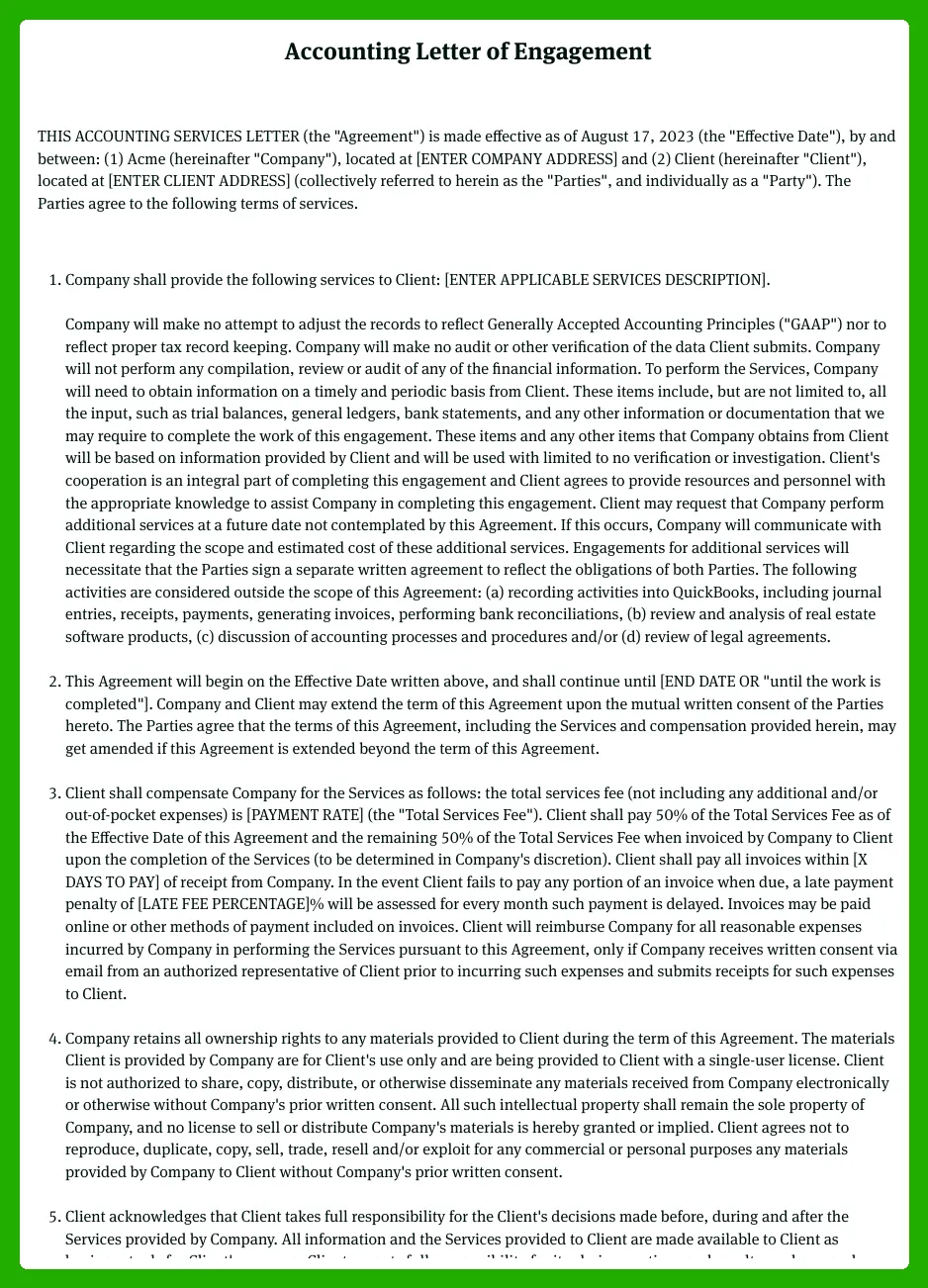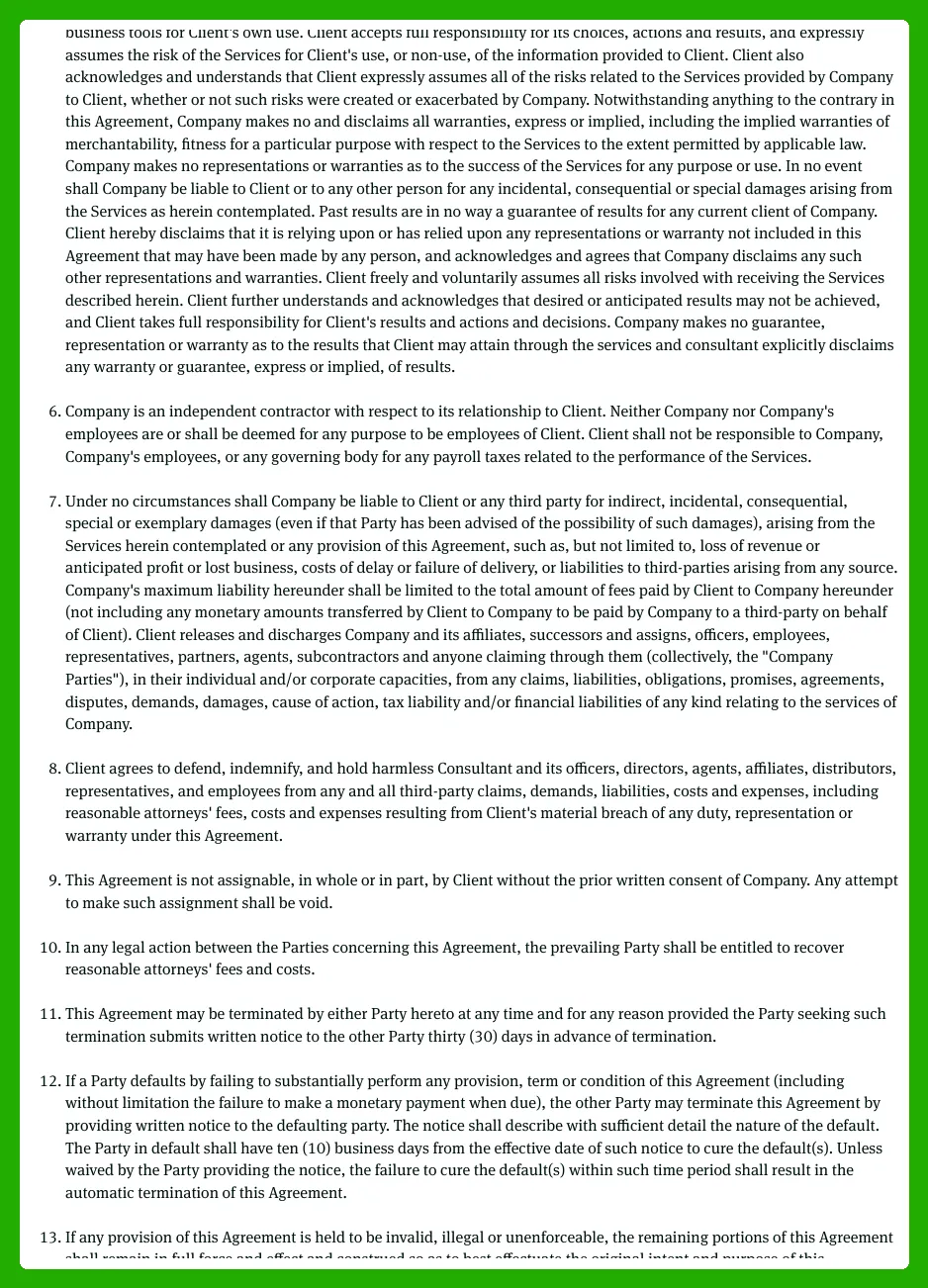Every company wants an effective way to engage clients and inform them of their relationship with the firm. However, not all forms of communication are ideal. Using an SOW or traditional contract may not be ideal. An accounting engagement letter, on the other hand, can be especially effective if utilized at the beginning of your client engagement.
This article is designed to let you know all you need about these letters. Throughout this article, we will touch upon the following:
- What these letters consist of
- The purpose of engagement letters
- The components of the letter broken down
- The benefits of engagement letters for accountants
- How to use your own template
- Tips and best practices to adopt
Introduction
Companies use various documents and letters to engage clients, keep them updated on recent developments and attract them. However, an accounting engagement letter might just be one of the most effective options available for your firm.
What Exactly is an Accounting Engagement Letter?
Letters of engagement for your accounting firm are legal documents you can send to your clients and inform them about their relationship with you. It is a clearly defined agreement that depicts the nature of the relationship, such as:
- The responsibilities to each other
- The products or services and their delivery
- Scope of work
- Payment terms and pricing
Importance of Having a Well-Written Accounting Engagement Letter
A well-drafted letter of engagement can be quite beneficial to a firm. As the name suggests, it can help engage clients while offering other benefits as well.
- Reduce Potential Firm Risk: An accounting engagement letter can help remove uncertainties and prevent any potential risks that might harm the firm. In addition, this letter can inform your clients by discussing what is expected of them and what they can expect from you. This makes the relationship far more thorough and mitigates misunderstandings.
- Reinforce Quality Standards: Clear quality standards encourage people to do business with your firm. A letter of engagement can set the standards of the relationship, as well as provide clients with the assurance that they made the correct choice.
- Prevent Scope Creep: A business’ scope should be clearly defined and focused. An accounting engagement letter can depict the terms, services, and payment structures in a manner that is consistent and enforces adherence.
The Purpose of an Accounting Engagement Letter
Letters of engagement are extremely important for accounting firms to ensure that all parties are on the same page. As such, it is imperative to consider what should be included.
What Your Accounting Engagement Letter Should Include
Your letter should include the following sections:
- A Brief Introduction -Introduce your company. This will help the clients know whom they’re communicating with.
- Company Overview -Talk about your mission, your services, and your customers. Clients deserve to know what business you’re in and what you represent.
- Professional Body Requirements -Describe the purpose of the letter and key items. Talk about how disputes should be handled as well. This serves to remove uncertainties.
- Pricing and Services -List your services and include their pricing. Providing clearly defined services can assure clients and encourage them to do business with you.
- Period of Engagement- Describe the extent of the engagement to mitigate risk.
- Payment Terms -Discuss how you will collect your payment and when. Payment plans and accepted forms of payment need to be clearly communicated ahead of time to reduce misunderstandings further down the road.
- Unanticipated Services -Explain what will happen when your work exceeds the agreed-upon conditions. This provides further assurance and information and removes uncertainties, especially when faced with untoward events.
- Service Terms - Go into detail, providing information about each service you provide. This section needs to make up the bulk of the letter as it contains vital information that the client is likely the most interested in.
- Confirmation of Terms -This is where the client signs their name. In addition, this section showcases their acknowledgment and agreement with the outlined terms and conditions.
How an Accounting Engagement Letter Differs from a Scope of Work
An engagement letter and scope of work are highly similar. However, for accounting firms, an accounting engagement letter can be much more appropriate. That is because it includes the contents of the scope of work, as well as additional information wherever relevant.
Key Elements of an Accounting Engagement Letter
Your engagement letter should include the following elements.
- Name of the Client - Provide the proper legal name of the client.
- Scope of Services - Clearly communicate what you are providing to the clients to reduce an instance of expectation gaps. The information should be provided with sufficient detail to avoid any misunderstanding.
- Accounting Firm Responsibilities - Be sure to include the details relevant to the services you’re providing. This will let your firm identify what it needs to do and maintain professional standards.
- Client Responsibilities - You should describe what the client is liable to do if they agree to your terms. Clearly defining the following details is essential to a long-term and fruitful relationship.
- Provision of the requested information and responding to inquiries in a timely way
- Maintaining internal controls
- Accepting responsibility for the results of the services rendered
- Making managerial decisions
- Providing particular representations when requested
Deliverables
The deliverables should include the work provided, services rendered, and delivered products. Again, there is a need to be specific and thorough in your description to mitigate uncertainties.
- Engagement Time - Identify when the services will begin and end. Also, describe any contingencies that are required before the service that may impact the start date. This clarification is essential to be on the same page with clients.
- Termination and Withdrawal -While it is not intended, there needs to be a clear policy when it comes to termination and withdrawal. Therefore, this statement in the engagement letter should describe how, when, and in which circumstances the services can be terminated.
- Billing and Fees - You should include a list of billing and payment fees that can clarify the cost of services to the client. This reduces the likelihood of fee disputes and helps the client identify any contingencies.
Benefits of Using an Accounting Engagement Letter Template
A template can help you out a lot when drafting your own engagement letter. You can benefit from their remarkable effectiveness by following the guidelines. However, before you start, it is important to recognize the benefits that are in store for you.
They Reduce Misunderstandings
Perhaps the most notable benefit of letters of engagement is the mitigation of uncertainties. As a result, potential misunderstandings are highlighted and removed before they can harm the quality of the exchange.
They’re Legally Binding Agreements
Since letters of engagement are legally recognized, it is possible to seek damages if one party does not abide by the agreed-upon terms and conditions. In addition, due to legal acknowledgment, potential counter-party risks are reduced.
They Set the Expectations of Clients and the CPA Firm
Engagement letters set the stage for the clients and the firms and provide a reference for expectations. They depict the time, delivery, payment, and other information of services as well as deadlines. This adds up and ensures that both parties know what to expect and prepare accordingly.
How to Use an Accounting Engagement Letter Template
Using an engagement letter properly involves knowing to whom you’re sending the letter and why. A template can help you put your ideas to paper much more easily. They can have specific section headings available for you to put your information in. A template can be a great help to CPAs that are not experienced in sending such letters.
Step-by-Step Instructions on Using Accounting Engagement Letter Templates
You can begin using letter templates by following the steps below:
- Find a Suitable Engagement Letter Template - First and foremost, you need to find a specific template that aligns with your client. Many letters of engagement exist, but for accounting purposes, it is imperative that you find one for a relevant business. This will save you time when you begin writing.
- Assess Its Relevance to Your Geolocation and Clientele -Letters of engagement differ based on geolocation. Each geographic area has its own regulation, structures, and nuances. As such, it is important that you identify one that pertains to your specific client’s location. If you want a template for the US market, this might be helpful.
- Provide Information About Your Specific Services Not Found on the Template -Often, the template would not have all of the information available. Products, services, dates, and regulations can vary from one firm to another. As such, analyze what needs to be changed and what can remain the same.
- Follow Through with Additional Details, Making Changes Where Necessary -You will need to make significant changes regarding the policies regarding engagement periods. You should assess your capacity to provide results and maintain the appropriate engagement period. Underquoting or overpromising is prone to backfire, so be realistic.
Amending the Engagement Letter Template to Suit Your Needs
There is a need to consider how you can amend a template to suit your needs. You can definitely create an engagement letter template from scratch, but doing so would require a lot of time and effort.
Finding a good template and amending it to your needs is much more effective. To properly amend a template, you must clearly define your services, periods, and other policies. Once you have them determined, all that is left is to amend the template accordingly.
Select a template that is relevant to your business and offers similar services. This will reduce the time needed to tweak. Furthermore, if you have more services than the template has space for, simply add them and follow the same procedure for added details as the services before.
Tips for Writing an Effective Accounting Engagement Letter
To ensure proper engagement, take care to follow the best practices of engagement letters.
Best Practices
- Be specific in terms of details
- Provide all the information a client might need
- Inform the client about the proper pricing and time in clear metrics
- Adhere to proper identification
- Know your client and your services well
- Use simple vocabulary, but be professional
- Proofread the letter
- Write disclaimers on a separate document
- Write a different letter for each service
- Express gratitude at the end
Pitfalls to Avoid
- Don’t be too brief
- Don’t dump more information than a reader is likely to read
- Don’t use a one-size-fits-all philosophy when writing through templates
- Avoid using abbreviations and superlatives
- Don’t write the same letter for different industries
Conclusion
In conclusion, it can be stated that letters of engagement play a pivotal role in maintaining a healthy and fruitful relationship. They keep the clients on the same page as the CPAs and encourage communication.
They have a proper format, with certain elements which need to be clearly depicted. As such, using templates can be great for firms that want to focus on efficiency. In addition, templates can provide CPAs to communicate their services, pricing, time periods, and disclaimers effectively.
However, the templates should not be used as is. Instead, they should be amended to suit your business and used with respect to the client in question. This will make the letter more efficient and reduce your chances of falling into pitfalls. A well-written letter can make all the difference between a satisfied client and a dissatisfied one.
Bonsai can help you find relevant accounting engagement letter templates that can boost your business. They are specially designed to prevent scope creep and require minimal amendments to be suitable. Sign up today for a 7-day trial and get more details!











%20(1).svg)
